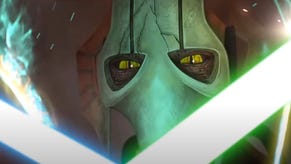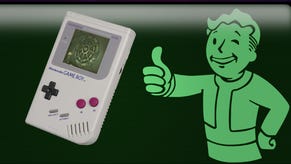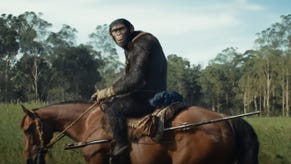Bloodborne alpha: why offense is the new defence
Dark Souls expert Dave Cook returns to VG247 to go hands-on with all four character builds in the Bloodborne alpha.
"In the pantheon of harrowing From Software settings, this is up there with the foulest of them, standing proudly beside the Tower of Latria in Demon's Souls."
There's a lot to be said for games that trigger genuine emotional feedback in players – be it a poignant ending, or the sensory kickback of an explosive set piece. These provocative 'beats' are what hold your interest from one minute to the next, and game studios are getting very good at seeding them at just the right intervals.
In Bloodborne there is no respite from the thin layer of trepidation coating every inch of Yharnam, a decaying city in the middle of a blood-soaked and violent collapse. Its 'beats' are constant, its savage tone incessant.
It's a place that balances your senses on a knife-edge, where the nearby sound of a rusty axe being dragged across blood-soaked cobblestones is enough to hurl you into full blown panic mode, if only for a millisecond. In the pantheon of harrowing From Software settings, this is up there with the foulest of them, standing proudly beside the Tower of Latria in Demon's Souls.
This week's PS4 alpha test opens in the same section of grimy Yharnam seen in both the gamescom and TGS demo builds, complete with rasping villagers, hulking mutants and that shrieking Cleric Demon boss. It has a real sense of place that combines Dickensian squalor with steampunk and Victorian tropes to produce something fresh – albeit utterly downtrodden.
The aesthetics help fuel Bloodborne's unrelenting tension, but nothing will get your heart racing as much as the game's lack of block button. Yes, Miyazaki and the wonderful sadists at From Software have seen fit to wrestle this simple ability from your hands, so simply hanging back and absorbing damage like a tank is not an option here.
What this means is that you are no longer grinding levels to raise your endurance or poise – a method fans of Dark Souls will no doubt be familiar with. This isn't a numbers game, where simply boosting your poison resistance will help you fell a toxic boss with greater ease. The days of playing the percentages and winning by simply harvesting levels are over.
Bloodborne favours those with good reflexes, discipline and the conviction to go all-in when the opportunity arises more than it spiritual predecessors. Pick any one of the alpha's four character builds, and you'll start to see the correlation between playing offensively and hanging back fairly quickly.
The familiar Dark Souls method of circling opponents to goad them into attacking still works here, but misjudge a foe's striking range and you may find your health whittled down to nought in seconds. You'll also feel like a weapons-grade wally. The key here is dodging and knowing when to retreat.
By tapping circle, players can execute a dodge roll, but doing this in close proximity to enemies sends your hunter darting back and forth to evade incoming blows. It is absolutely imperative that you hot-wire evasion into your brain in order to survive even the most basic of encounters, while keeping one eye on how stamina you have left.
Suffer an incoming attack and you have a short window in which to win back your lost health. This is a genius risk/reward mechanic, in that it forces players to go on the counter-offensive or risk losing their idling HP. Reply to damage too hastily or without rational thought and you will fall in moments, but do it right and you can regain your full health bar. The pay-off is monumental.
"Ranged weapons are useless as a killing tool, but are effective at crowd control due to their violent knock-back capacity, and their ability to break enemy attack patterns."
I lieu of ditching shields, Bloodborne offers players the ability to switch between two distinct weapon modes. My favourite sample build was the Warped Blades dual-wielder, whose rapid attack speed made regaining lost health much simpler. His damage output is considerably lower, but with a simple tap of L1 players can combine both blades to make one slower, stronger weapon.
The Kirkhammer class is also brilliant, offering slow, wide slams with a hulking engraved cudgel. Hit the weapon change prompt and your hunter detaches the hammer's handle to reveal it was actually a sword, leaving you free to dish out faster swipes when faced with swift enemies. Knowing the subtleties between each weapon mode and type is crucial, given the importance of reach and attack speed.
There is also a standard sword class that offers a savage charge attack that releases when players hit full capacity, so timing is important to avoid slicing thin air. Each alpha character came with a firearm, which by no means made winning battles easy. Ammo is scare – a maximum of 20 silver bullets in the alpha, and damage per discharge is low whether using a blunderbuss or pistol.
Ranged weapons are useless as a killing tool, but are effective at crowd control due to their violent knock-back capacity, and their ability to break enemy attack patterns. If you sense you're unable to successfully dodge the incoming ground pound of an ogre, just unload a swarm of buckshot into his face to send him reeling. It's a clever addition to your arsenal.
This might sound odd, but I used guns as a stealth tactic – which seems completely contradictory. It is entirely possible to bypass packs of enemies in this game by simply waiting for things in the environment to happen. Early on you will encounter a broad plaza complete with flaming pyre and a large mob of villagers that would give Leon Kennedy nightmares.
Wait long enough and church bells will ring, the throng of bodies disperses and enters patrol mode, leaving you with less enemies to fight. Hunters can also hurl pebbles at enemies or wing them with well placed bullets to draw them away from groups. This is particularly effective at luring out individuals and taking them out one by one.
Some enemies can be skirted around altogether by picking opportune moments before running to the next area. This all goes back to the visual cues I mentioned earlier – such as the sound of axes being dragged along the road. It's the game's way of telling you enemies are drawing near, giving you a window to either turn tail and consider your options, or switch weapon mode to prepare for a fight.
For all its differences, Bloodborne retains some of the Dark Souls DNA, such as helpful messages scrawled on the ground by players – now appearing as skeletons writing out of the ground holding scrolls. Players can now rate scribblings as either 'fine' or 'foul' although it's currently unclear what effect up or down voting has on the author.
Torches return from Dark Souls 2, but they are now limitless and mapped to the left d-pad, while Blood Vials replace Etsus Flasks, and must be found in the world rather than simply topped up at bonfires. Speaking of which, the game's checkpoint system has yet to be revealed, and there didn't seem to be a soul gathering mechanic at play.
Death was also met with a Bloodborne logo screen that kicked in just before the synonymous 'You Died' message would have typically flashed on screen. There is ample time for these mechanics to be revealed, but to be frank, I'm happy with Miyazaki and team's willingness to take significant steps away from the Souls template.
I enjoy all three of those games immensely, yet I'm keen to see the format evolve under Miyazaki's direction. The emphasis on active engagement and offensive play is welcome, and the horror aesthetic leaps off the screen – primarily because it's a style we haven't seen in some time, although The Order: 1886 and retro classic Nightmare Creatures spring to mind as comparisons.
"As a huge Dark Souls fan, I'm happy – rather than dismayed, that the format has shifted so radically in Bloodborne, and although it may look the same in trailers, your approach genuinely had to change in order to survive the most basic of enemy encounters."
I'll close with where my Bloodborne experience ended – that Cleric Demon boss. I actually found the werewolves and axe-wielding ogre harder, and I think that has a lot to do with them being both smaller and faster. Their attack patterns were harder to read, and were certainly veiled to a greater extent.
It's hard to miss the Cleric's giant, swinging arms as they rain down on top of you, so in that respect dodging and lashing out in kind was certainly much simpler. I should also point out that the werewolf encounter also sees the player accompanied by an NPC hunter, who is a great help during this skirmish.
I didn't beat the boss by the time the servers went offline, but this one of my few complaints. I also encountered some moments of slow-down, an abundance of repeated enemy dialogue and some frame rate stutters, but I suspect the technical issues are only restricted to the alpha.
As a huge Dark Souls fan, I'm happy – rather than dismayed, that the format has shifted so radically in Bloodborne, and although it may look the same in trailers, your approach genuinely had to change in order to survive the most basic of enemy encounters.
Make no mistake: this is a brutal game that will test even the most seasoned Souls player, and I'm looking forward to relearning everything I thought I knew about the template when it drops in February.












